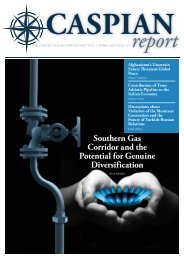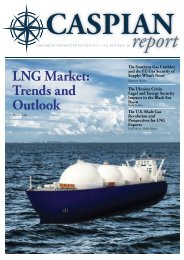Caspian Report - Issue 06 - Winter 2014
Create successful ePaper yourself
Turn your PDF publications into a flip-book with our unique Google optimized e-Paper software.
ROBERT M. CUTLER<br />
34<br />
Bosnia-Herzegovina, Croatia, Kosovo,<br />
Macedonia, Montenegro, and Serbia.<br />
It should be noted that Romania accounts<br />
for about two-thirds of these<br />
totals, and Bulgaria for a third of remainder.<br />
However, these figures appear<br />
to have been predicated on precrisis<br />
conditions.<br />
The supply gap then projected among<br />
the SEE-7 countries (i.e. excluding EU<br />
members Romania and Bulgaria)<br />
was 3.0 bcm for 2010, 4.0 bcm for<br />
2015, 6.5 bcm for 2020, and 8.0 bcm<br />
for 2025. 3 However, by 2012 this<br />
gap was already close to 4.5 bcm, of<br />
which Serbia and Croatia together accounted<br />
for nearly six-sevenths. The<br />
extremely harsh winter in the region<br />
accounted for this strong demand,<br />
against a background of otherwise<br />
reduced consumption due to the economic<br />
crisis. 4<br />
At the penultimate stage of pipeline<br />
selection for Shah Deniz Two, in September<br />
2011, a BP-proposed pipeline<br />
project called the South East Europe<br />
Pipeline (SEEP) was announced. It<br />
would have run from eastern Turkey<br />
to eastern Austria through Bulgaria,<br />
Romania, and Hungary. However,<br />
there were conflicting reports<br />
naming either Croatia or Slovenia<br />
as transit countries; other reports<br />
named neither of them. Yet neither<br />
was actually required, since the destination<br />
gas hub of Baumgarten an der<br />
March is in eastern Austria, about 65<br />
kilometers from the country’s border<br />
with Hungary.<br />
Croatia and Slovenia are, along with<br />
their neighbors, among those European<br />
countries with the least diversified<br />
gas supply. Consequently<br />
the mention of them as purchasers<br />
would have gone hand in hand with<br />
the construction of relatively inexpensive<br />
bi-directional gas interconnectors,<br />
creating a gas ring in the<br />
region and increasing the energy<br />
security of all involved. The European<br />
Commission endorsed such<br />
engineering projects in principle as<br />
early as 2008 under the umbrella of<br />
its “supergrid” project, permitting<br />
EU member states to share electric<br />
power from different sources. 5 Only<br />
with Lithuania’s recently concluded<br />
presidency of the EC, however, with<br />
its specific Energy Agenda, were<br />
those projects in Southeast Europe finally<br />
included in the EU budget under<br />
a regular heading for completion.<br />
2.3. South Stream and the SGC<br />
Moscow continues to insist that South<br />
Stream is none of the EU’s business,<br />
3<br />
. See “Projected supply gap in seven SEE markets,” Figure 13 in the original feasibility study, South East<br />
Europe: Regional Gasification Stud; Final <strong>Report</strong>, p. 49. The study was executed by a consortium<br />
of four industry consulting firms and is available at . Compare Anastasios Giamouridis and Spiros Paleoyannis, Security of Gas<br />
Supply in South Eastern Europe: Potential Contribution of Planned Pipelines, LNG, and Storage, NG-<br />
52 (Oxford: Oxford Institute of Energy Studies, July 2011). All URLs cite were retrieved and verified<br />
on 21 February <strong>2014</strong>, unless otherwise stated.<br />
4<br />
. For details, see Energy Community Secretariat, Annual <strong>Report</strong> on the Implementation of the Acquis<br />
under the Treaty Establishing the Energy Community, September 2012, < http://www.energycommunity.org/pls/portal/docs/1770178.PDF>.<br />
5<br />
. For an introduction and background, see Energy Community, “Gas Ring Concept,” .










